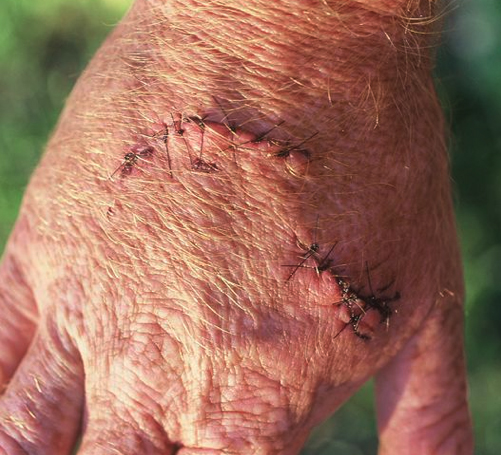Did you know that rattlesnakes regulate the volume of their venom? A mouse needs only a little dose and a rat a little more. A rabbit may receive a little more venom than a rat. Rattlers sometimes bite humans without injecting venom. A snake that feels in danger may "deliver everything it has." About 6,000 people are bitten in North America each year. In about 80 percent of those cases, experts say, the victim was trying to handle the snake. A half century ago, fatalities were common. Not so today. Medical treatment is usually nearby, and antivenin is effective. Only one in about 700 bites results in death. If you don't die, the greatest danger is hock caused by dangerously low blood pressure that can deprive the brain and other organs of oxygen. Some snakebite victims bleed internally. Even with treatment, a survivor might lose flesh, muscle tissue, nerves, bone, even a limb.
Don't think rattlesnake venom is all that bad? Think again. A well-known snake expert, 61-year old Joe Wasilewski, was recently bitten in Florida and nearly lost his life. And that was someone who knew what he was doing— someone who has handled hundreds thousands of snakes during the last 50 years. Someone also used to handling crocodiles. But all it took was one mean viper to "deliver everything it has" and this expert almost didn't make it. Writer Jeff Klinkenberg of the Tampa Bay Times reported the story:
 Wasilewski had opened a cage and used a short pole to lift a buzzing 4-foot diamondback rattlesnake. In a well-practiced move, he slid the snake into a garbage can for safekeeping while he cleaned the cage. Then it was time to reverse the process. Hook the snake in the middle, position head away from you, slide it back into the cage. But then Joe felt a sharp sting in his left forearm.
Wasilewski had opened a cage and used a short pole to lift a buzzing 4-foot diamondback rattlesnake. In a well-practiced move, he slid the snake into a garbage can for safekeeping while he cleaned the cage. Then it was time to reverse the process. Hook the snake in the middle, position head away from you, slide it back into the cage. But then Joe felt a sharp sting in his left forearm.
"Oh, oh,'' he told his son, Nick. "I think he got me.'' While his son called 911, Wasilewski got a funny metallic taste in his mouth. His lips tingled, he sweated profusely, he threw up. By the time he was taken to the hospital, Wasilewski was unconscious. His blood wasn't clotting. He'd received eight vials of antivenin. Then he got another eight. His arm was grotesque and swollen. Standing next to his dad's bed in intensive care, Nick stared in shock at the stricken arm. The twitching muscles made it look like worms wriggling under the skin.
Antivenin costs about $3,200 a vial. Why so expensive? First, lots of venomous snakes have to be captured. Their venom is extracted and injected into horses and sheep, whose blood forms antibodies against the poison. Finally, the animal blood is made into a product to treat humans.
Eventually Wasilewski improved. Opened his eyes. Talked. Then suffered a relapse. His blood had stopped clotting again. The swollen arm was turning black. Over the next three days his doctor ordered another 32 vials. Joe endured tubes up his nose, down his throat, in his penis, in his arm. Morphine. Fog. Day, night, another day. Improvement. Awake. Tubes came out. Ate some food. For the first time in more than a week, this man who was used to being around rattlesnakes, felt alive.
"I can't take another bite like that,'' Joe told friends who stopped by his home after Joe was released from the hospital. Joe has two Eastern diamondbacks. He has decided that he'll keep one of them for educational purposes. The other he'll give to a pal in Central Florida in the venom business. It is amazing that this South Florida longtime reptile wrangler has no hard feelings. “It was my own fault,” said Wasilewski. “I got careless. It’s not the snake’s fault.”
If a situation can happen to this expert, imagine what can happen out of the blue when hiking, hunting, stacking wood, or camping in rattlesnake habitat without the right protection. Don't take a chance! When in the desert or woods -- anywhere rattlesnakes are known to live -- protect yourself with snake gaiters or snake boots. This type of snake bite protection enables YOU to "deliver everything you have" when it comes to not getting bitten.